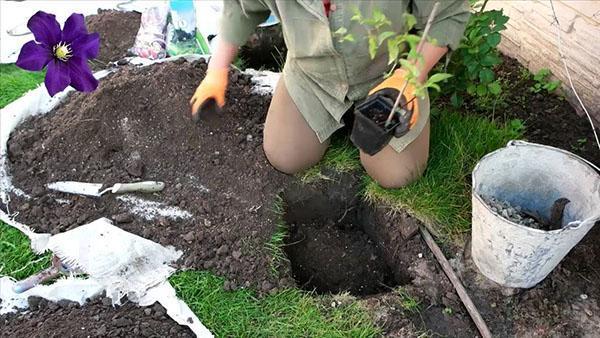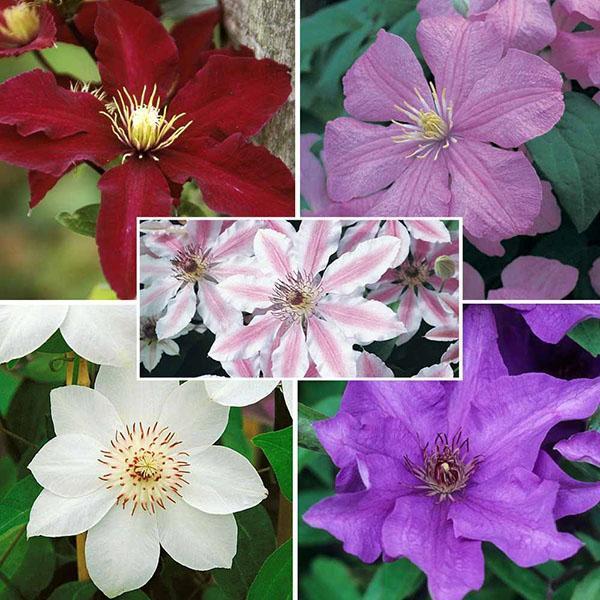Choosing clematis exclusively for the Moscow region
 When choosing ornamental plants for your summer cottage, you need to take into account the climate of that region. Therefore, clematis for the Moscow region (varieties, their description and photos further) must be resistant to sudden changes in weather conditions. The main feature of these tropical "inhabitants" is that they are warm and light-loving. In temperate latitudes, only cultivation of hybrid varieties feels comfortable. Moreover, they throw out lush and abundant blooms, without requiring painstaking care from the gardener.
When choosing ornamental plants for your summer cottage, you need to take into account the climate of that region. Therefore, clematis for the Moscow region (varieties, their description and photos further) must be resistant to sudden changes in weather conditions. The main feature of these tropical "inhabitants" is that they are warm and light-loving. In temperate latitudes, only cultivation of hybrid varieties feels comfortable. Moreover, they throw out lush and abundant blooms, without requiring painstaking care from the gardener.

Moscow region, meet the following varieties
 So gentle from above, but in fact - strong and persistent. This description is quite suitable for these decorative vines. In the wild, they can be found anywhere. This could be:
So gentle from above, but in fact - strong and persistent. This description is quite suitable for these decorative vines. In the wild, they can be found anywhere. This could be:
- forest;
- rocky slopes;
- steppe;
- river valleys.
 They appear before the tourist either in the form of curling vertical "carpets" or mighty shrubs. Such wild species have miniature flowering. While the varieties of clematis for the Moscow region (photo with descriptions just below) are distinguished by large flowers. They can be of all kinds of shades from snow-white to black and burgundy. There are varieties in which flowers are collected in luxurious inflorescences of 3-7 pieces in a bunch. The shape of each of them is striking. The flower can be represented:
They appear before the tourist either in the form of curling vertical "carpets" or mighty shrubs. Such wild species have miniature flowering. While the varieties of clematis for the Moscow region (photo with descriptions just below) are distinguished by large flowers. They can be of all kinds of shades from snow-white to black and burgundy. There are varieties in which flowers are collected in luxurious inflorescences of 3-7 pieces in a bunch. The shape of each of them is striking. The flower can be represented:
- half-umbrella;
- with a panicle;
- flap.
 You can admire these lovely buds already in May, and you will have to say goodbye to them in September. The main stems are about 5 meters long. They are exquisitely decorated with dark green foliage. Due to the fact that the leaves are arranged in pairs or alternately, the plant has a gorgeous look. In one place, these hybrids can "live" for more than 30 years. However, you need to know that varieties with a core root system are not recommended to be transplanted.
You can admire these lovely buds already in May, and you will have to say goodbye to them in September. The main stems are about 5 meters long. They are exquisitely decorated with dark green foliage. Due to the fact that the leaves are arranged in pairs or alternately, the plant has a gorgeous look. In one place, these hybrids can "live" for more than 30 years. However, you need to know that varieties with a core root system are not recommended to be transplanted.
Shoots can develop very intensively. Thus, dense bunches form in the middle of the bush, which eventually dry out. Therefore, they need to be thinned, and the bush itself must be cut off. This does not affect the splendor of the flowering in any way.
"Ville de Lyon" - Monsieur from France
 It tolerates cold mid-latitude winters well, so its branches do not need to be covered. The gardener does not have to worry that the foliage and the stem will infect fungal or any other diseases. He has excellent immunity. As you might expect, only a real Frenchman can boast of such endurance.
It tolerates cold mid-latitude winters well, so its branches do not need to be covered. The gardener does not have to worry that the foliage and the stem will infect fungal or any other diseases. He has excellent immunity. As you might expect, only a real Frenchman can boast of such endurance.
Throughout the summer, the owners will admire its carmine red flowers, which expand to 12-15 cm in diameter. These variegated umbrellas look harmonious on young brownish shoots (grow up to 4 m). The deep red petals of Ville de Lyon clematis are painted with light ripples. At the same time, the shaggy middle adds a certain exoticism to this "carpet of love".
For planting, early spring or autumn is suitable. It is desirable that the threat of nighttime temperature drops has already passed.
"Gypsy Queen" - blue bloods
 This variety is also called the "Queen of the Gypsies". In fact, the overall purple-violet flowers with thinned petals (4-6 pcs.) Resemble the skirt of a Romanesque girl. In diameter, these velvety umbrellas can be either 11 or 18 cm.They are decorated with purple anthers, which are crushed by scarlet pollen. Clematis "Gypsy Queen" is appreciated by many summer residents for:
This variety is also called the "Queen of the Gypsies". In fact, the overall purple-violet flowers with thinned petals (4-6 pcs.) Resemble the skirt of a Romanesque girl. In diameter, these velvety umbrellas can be either 11 or 18 cm.They are decorated with purple anthers, which are crushed by scarlet pollen. Clematis "Gypsy Queen" is appreciated by many summer residents for:
- disease resistance;
- lush bloom, not fading in the sun;
- frost tolerance (up to -30 ° С);
- the ability to thrive in shaded areas.
The flowering period begins at 15 July and lasts until the first October frost. On the young shoots (top five), luxurious buds bloom. There can be up to 20 of these charming "beauties" on the stem in total.
The choice of location is very important. The site should warm up moderately and be illuminated by the sun. Excessive shade and heat will be detrimental to him. The plant should be planted 20-35 cm from the wall / fence.
"Rouge Cardinal" - a person of the clergy
 Translated from French, this name sounds like a red cardinal. It is quite suitable for a plant. Large velvet flowers have a burgundy hue. When the bush blooms in the spring, it inspires some kind of awe. Its spectacular appearance transports observers to the era of the Musketeers. This description of clematis Rouge Cardinal fully justifies its name.
Translated from French, this name sounds like a red cardinal. It is quite suitable for a plant. Large velvet flowers have a burgundy hue. When the bush blooms in the spring, it inspires some kind of awe. Its spectacular appearance transports observers to the era of the Musketeers. This description of clematis Rouge Cardinal fully justifies its name.
Young shoots of climbing vines must be tied up so that the shrub grows in the right direction, acquiring the desired shape. As a result, during the summer months, he will start up from 3 to 5 shoots.
Saline, acidic, damp and heavy soils are not suitable for such varieties. The alkalinity should be as low as possible, neutral. Loamy fertilized soil is ideal.
"General Sikorsky" - a military leader and a politician rolled into one
 This type of clematis came to Russia from Poland. It was here in 1965 that breeders bred a hybrid that is resistant to sudden changes in temperature, as well as to fungal diseases. Bright purple petals with a bluish tinge are excellently woven over living supports from:
This type of clematis came to Russia from Poland. It was here in 1965 that breeders bred a hybrid that is resistant to sudden changes in temperature, as well as to fungal diseases. Bright purple petals with a bluish tinge are excellently woven over living supports from:
- trees;
- bushes;
- phytowall.
Clematis "General Sikorsky" can be safely grown even in a container. Its foliage and flowering will be as lush and dense as possible if it is planted in partial shade. Despite such a high-profile title, this variety does not tolerate heat. The dry summer leads to the fact that it fades quickly. In this case, the buds acquire a pale shade.
After planting, the seedling needs feeding. Nitrogen-containing fertilizers are applied during the growing season so that clematis blooms magnificently. By the end of spring, add ash or potash fertilizer to the soil. Organic matter and peat just destroy the young sprout.
Luther Burbank is more than a breeder
 A unique hybrid of a tropical vine was named in honor of this great scientist. This man was a pioneer in breeding.
A unique hybrid of a tropical vine was named in honor of this great scientist. This man was a pioneer in breeding.
A purple curtain carpet of large flowers will impress any passer-by. This luxury can be enjoyed for six months. Among the important features clematis Luther Burbank can be distinguished as follows:
- the stem grows up to 5 meters;
- the size of one flower is about 24 cm in diameter;
- up to 10 lianas develop in one bush;
- the anthers are very large.
Up to 12 flowers can be found on one shoot. The elliptical shape of the pleated petals creates a dramatic look.
In each subsequent season, the plant needs to be deepened. To do this, you can simply cover the root collar with another layer of earth.
"Nikolay Rubtsov" - lyrical digression
 Apparently, the extraordinary coloring of these colors has become a portal of inspiration for many poets. In this regard, he was named after one of them. His description is worthy of a literary work. On the lilac umbrellas of clematis, Nikolai Rubtsov, as if with a brush, made original white stripes. In the middle, an anther amphora rises above the petals, which resembles some kind of precious Renaissance vase. The branches of the hybrid are so tightly intertwined that they form a lush wreath / tiara of bright colors. On the shoots, the buds last for about a month, and then fall off.
Apparently, the extraordinary coloring of these colors has become a portal of inspiration for many poets. In this regard, he was named after one of them. His description is worthy of a literary work. On the lilac umbrellas of clematis, Nikolai Rubtsov, as if with a brush, made original white stripes. In the middle, an anther amphora rises above the petals, which resembles some kind of precious Renaissance vase. The branches of the hybrid are so tightly intertwined that they form a lush wreath / tiara of bright colors. On the shoots, the buds last for about a month, and then fall off.
They are also not recommended to be planted in open areas, otherwise they may turn pale.
"Niobe" - the disapproval of the gods
 The breeders decided to name this beautiful clematis Niobe, as its crimson flowers remind them of the story of a grieving mother. In an instant, she lost 14 children, executed at the behest of the ruthless Diana and Apollo. It is the dark red hue of the wavy petals that testifies to her grief. Yet this is only a myth.
The breeders decided to name this beautiful clematis Niobe, as its crimson flowers remind them of the story of a grieving mother. In an instant, she lost 14 children, executed at the behest of the ruthless Diana and Apollo. It is the dark red hue of the wavy petals that testifies to her grief. Yet this is only a myth.
The shrub grows up to 1 meter in width and up to 2.5 meters in height. In spring, on the shoots, you can observe black buds with a slight tint of a reddish tint. Over time, they brighten.
Although the hybrid is considered frost-hardy, nevertheless, agronomists recommend wrapping branches tightly for the winter.
"Nelly Moser" - oh, what a woman
 Having seen these pink and white umbrellas for the first time, many are ready to exclaim this phrase. A wide pink stripe is drawn in the center of each of the 9-11 snow-white petals. Unlike all other clematis varieties, Nelly Moser has a unique sepal structure. The petals are arranged in two rows, staggered. Thanks to this structure, they look extremely impressive. When growing a plant, it is worth considering the following points:
Having seen these pink and white umbrellas for the first time, many are ready to exclaim this phrase. A wide pink stripe is drawn in the center of each of the 9-11 snow-white petals. Unlike all other clematis varieties, Nelly Moser has a unique sepal structure. The petals are arranged in two rows, staggered. Thanks to this structure, they look extremely impressive. When growing a plant, it is worth considering the following points:
- flowering fades in the scorching sun;
- the first buds appear on old branches by the end of spring;
- in autumn they can be observed on young shoots.
In dry weather, the plant should be watered more often than once a week. After this procedure, it is important to loosen the soil, removing all weeds from the garden.
"Ballerina" - grace in every contour
 The appearance of this "beauty" reminds many of a bride. However, the crimson, slightly furry center immediately destroys this illusion. It was the outstanding ballet actress Maya Plisetskaya who became the muse who inspired the botanists to create this miracle.
The appearance of this "beauty" reminds many of a bride. However, the crimson, slightly furry center immediately destroys this illusion. It was the outstanding ballet actress Maya Plisetskaya who became the muse who inspired the botanists to create this miracle.
The stem of clematis "ballerina" weaves slowly. It stretches only up to 3 meters. On the green leaf of the leaves, magnificent white blooms stand out brightly (each 15 cm in diameter). The bush has such a spectacular appearance that even roses... The buds bloom on both last year's (in June) and young (in July) stems.
3-5 hours before planting, the root of the seedling must be soaked. In the hole, the first step is to lay the drainage, cover it with earth (5 cm layer) and gently spread the roots of the plant.
"Hope" never dies
 Undoubtedly, this name immediately speaks to everyone about a Soviet woman. In 1969, the variety was bred by a simple flower lover who decided to perpetuate the memory of her sister, calling it Clematis "Hope".
Undoubtedly, this name immediately speaks to everyone about a Soviet woman. In 1969, the variety was bred by a simple flower lover who decided to perpetuate the memory of her sister, calling it Clematis "Hope".
Twice a season (summer and autumn), this unique specimen throws out large pale pink blooms. A bright purple stripe looks gracefully on the petals. While yellowish anthers are delightfully combined with spreading petals.
The stem should be cut in late October or early November.
From a detailed description and vivid photos of ten varieties of clematis intended for the Moscow region, each gardener can choose several at once. They grow without problems in the neighborhood of each other, creating amazing living curtains in the country.